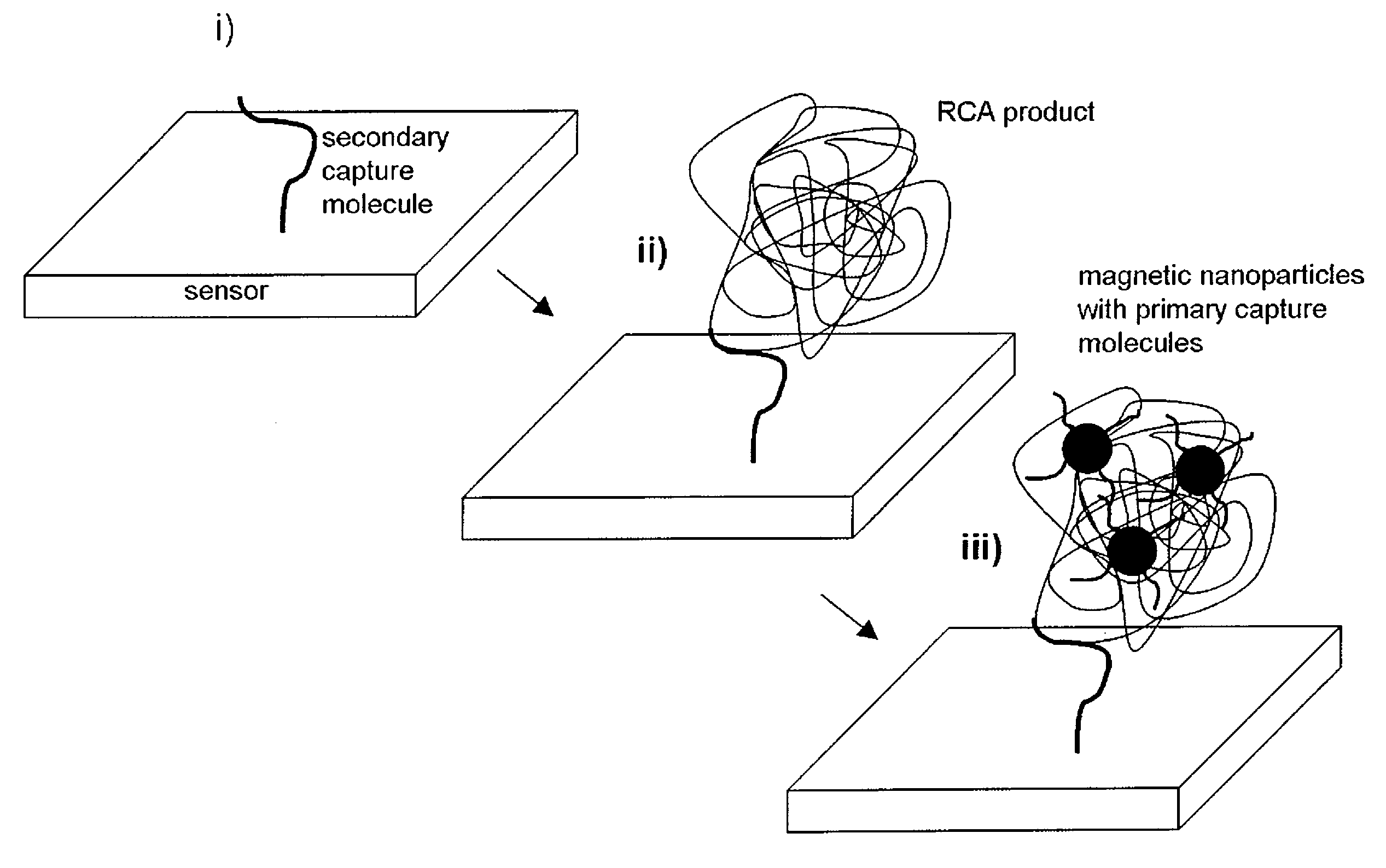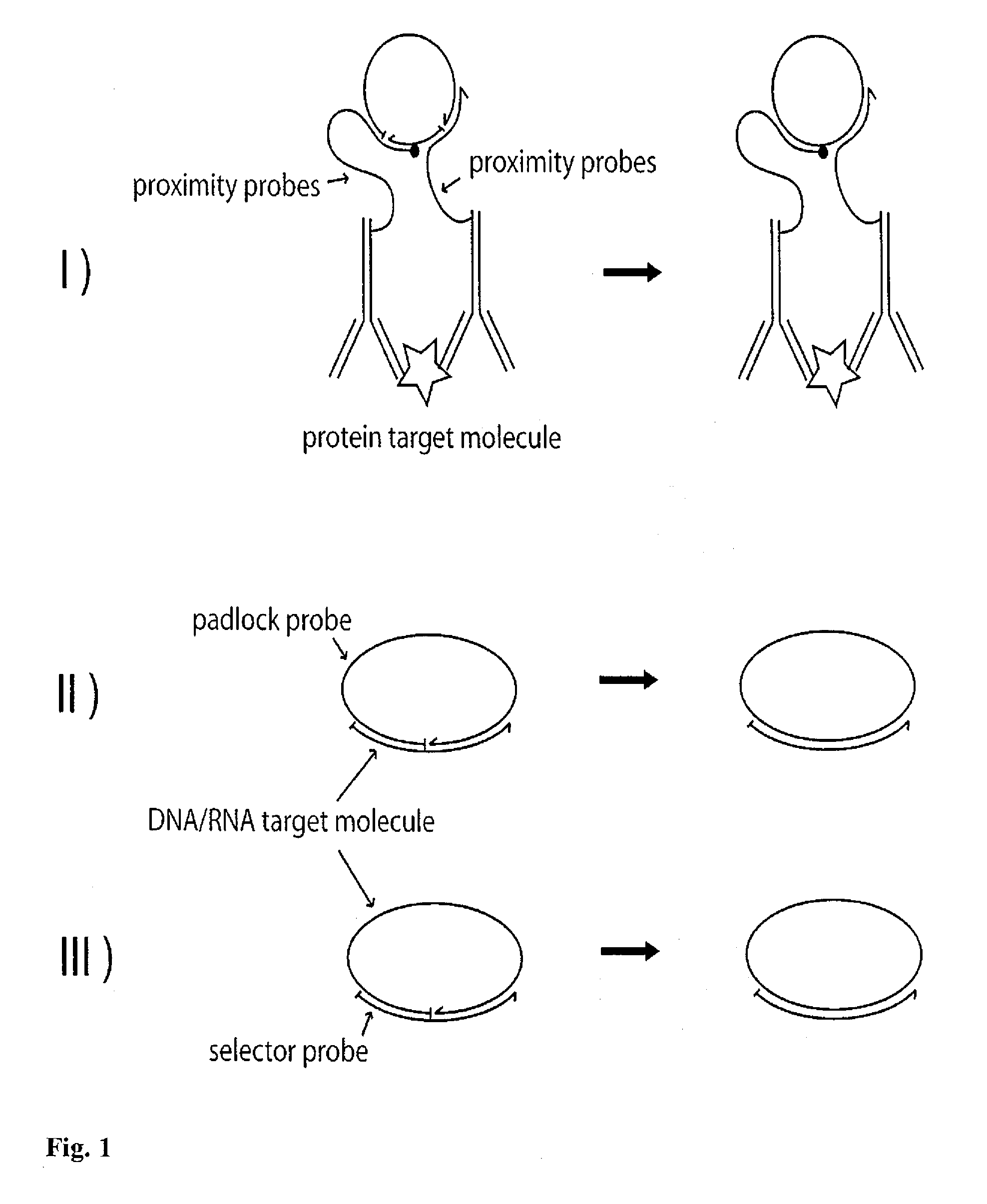Magnetic Detection of Small Entities
a small, magnetometer technology, applied in the field of magnetometer of small entities, can solve the problems of limited sensitivity and specificity, relatively labor-intensive and time-consuming microarray analysis, and not very suitable for diagnostics, and achieve the effect of reducing costs
- Summary
- Abstract
- Description
- Claims
- Application Information
AI Technical Summary
Benefits of technology
Problems solved by technology
Method used
Image
Examples
example 1
Detection of Single-Stranded DNA Using the RCA Technique
[0075]FIG. 4 shows an example of the invention implemented as single target DNA sequence detection step by step, using the RCA technique for amplification purposes. In upper left part of the figure, a solution containing single-stranded target-DNA molecules, indicated as curved black lines, is shown. Linear padlock probe molecules (curved white lines) designed to exactly match the target-DNA are added, which upon hybridization with the target-DNA molecules form circularized padlock probes. The ends of the padlock probe molecules are joined together by ligation. DNA polymerases are added and the RCA of the circularized padlock probes proceeds for a certain time (the RCA-time). After completion of RCA, the solution comprises random-coil single-stranded molecules having an approximate size of 1 μm (for an RCA-time of approximately 1 hr) [Strömberg et al. 2008a].
[0076]The presence of the RCA-coils is detected by addition of magneti...
example 2
Quantification of Single-Stranded DNA Using the RCA Technique (Amplification Before Binding to Magnetic Nanoparticles)
[0080]FIG. 5 (a) shows the imaginary part of the complex magnetization vs. frequency at 310 K for positive samples with various RCA-coil concentrations, ranging from 0 to 300 pM. The magnetic properties of the synthesised probe-tagged magnetic nanoparticles were found to be highly reproducible. The “0 M” curve corresponds to the negative control sample without RCA-coils [Strömberg et al. 2008a].
[0081]FIG. 5 (b) shows Δm″, defined as Δm″=m″(0)−m″(c), at the high frequency Brownian relaxation peak vs. RCA-coil concentration, c. Note the very clear correspondence between the high frequency peak m″ level and the RCA-product concentration. As the RCA-product concentration increases, more probe-tagged magnetic nanoparticles are incorporated into coils and therefore, the high frequency peak m″ level decreases [Strömberg et al. 2008a].
[0082]The high and low frequency Brownia...
example 3
Quantification of Single-Stranded DNA Using the RCA Technique (Amplification after Binding to Magnetic Nanoparticles)
[0086]In the above examples the hydrodynamic volume of the target molecule to be detected was enlarged before the binding reaction to functionalized magnetic nanoparticles exhibiting Brownian relaxation behavior. In another implementation of the present invention the hydrodynamic volume of the target molecule that binds to the magnetic nanoparticle is increased after such a binding reaction and prior to read-out.
[0087]To exemplify this, thiol modified oligonucleotide probes were immobilized on aminated 130 nm-sized magnetic nanoparticles using SPDP coupling chemistry [Strömberg et al. 2007b, Strömberg et al. 2008a] composed of a non-magnetic dextrane shell enclosing a magnetic aggregate consisting of 15 nm maghemite (γ-Fe2O3) nanoparticles, with each nanoparticle being in a single domain state. The types of probes and nanoparticles may however vary depending on desire...
PUM
| Property | Measurement | Unit |
|---|---|---|
| Fraction | aaaaa | aaaaa |
| Fraction | aaaaa | aaaaa |
| Fraction | aaaaa | aaaaa |
Abstract
Description
Claims
Application Information
 Login to View More
Login to View More - R&D
- Intellectual Property
- Life Sciences
- Materials
- Tech Scout
- Unparalleled Data Quality
- Higher Quality Content
- 60% Fewer Hallucinations
Browse by: Latest US Patents, China's latest patents, Technical Efficacy Thesaurus, Application Domain, Technology Topic, Popular Technical Reports.
© 2025 PatSnap. All rights reserved.Legal|Privacy policy|Modern Slavery Act Transparency Statement|Sitemap|About US| Contact US: help@patsnap.com



